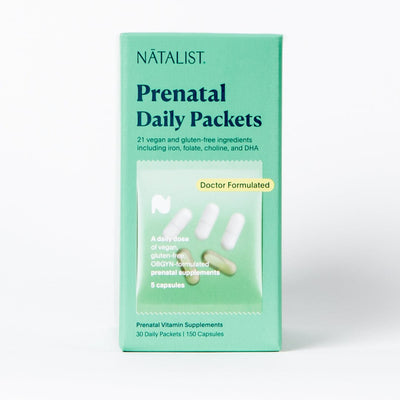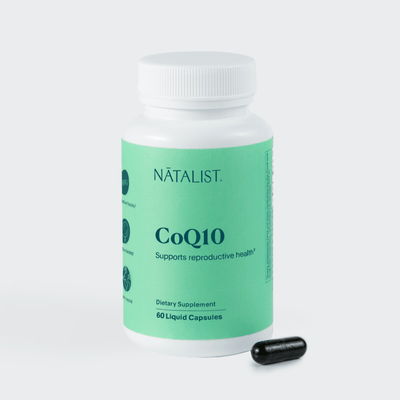The IVF Funnel: Understanding Your Chances of Success

Originally published 08/27/2020. Updated for accuracy and relevancy on 02/18/2024
Setting realistic expectations around IVF success is important. In this guide, IVF warrior and Natalist Founder Halle Tecco walks through the IVF funnel and the process from egg retrieval to bringing a baby home.
By Halle Tecco , MBA, MPH
Assisted reproductive technology has become popular in human reproduction, including freezing eggs and in vitro fertilization. In vitro fertilization (IVF) has come a long way since the first IVF baby was born in 1978. Research shows that in 2000-2001, the success rate for women under 38 was 25.1%.1 Fast forward 2 decades and we see that number at 32.4% for women ages 35-37, and 44.5% for women under age 35.2
I am forever indebted to the doctors and scientists who have enabled me to become a parent through this incredible process. But it has not been without heartbreak—including failed retrievals (two), failed transfers (two), and miscarriages (five).
I wrote this guide because I wish I had understood the "IVF Funnel" when I began my journey. When I did my first egg retrieval at 33 and got 14 mature eggs, I was so excited! Little did I know that the number of eggs retrieved ≠ the number of babies. There are many steps in between, and anyone starting the long, difficult, and expensive process of IVF deserves a good understanding of their chances of having a baby.
Understanding the basics of IVF and the process can give you a better insight into how it works and how the chances of success can be determined.
Step 1: Mature Eggs Retrieved
Research shows that there’s a strong association between the number of eggs retrieved at the egg retrieval and live birth.3 Your fertility doctor will have a good estimate of how many eggs they will likely retrieve based on your ovarian reserve and medication protocol.
There’s a strong association between the number of eggs retrieved at the egg retrieval and live birth.
Your ovarian reserve is determined through baseline hormone testing at the beginning of your menstrual cycle. These hormones include Follicle Stimulating Hormone (FSH), Estradiol, and Anti-M üllerian Hormone (AMH). They will also look at antral follicle count, which is done via an invasive ultrasound that looks at the follicles in the ovary containing mature egg (pro tip: you can BYOL— bring your own lube —for the ultrasound probe).
An average of ten to 20 eggs are usually retrieved for IVF, but the number can be higher or lower. You would think more eggs is always better, but that’s not the case. Researchers who analyzed thousands of IVF cycles found that the magic number of eggs retrieved from IVF treatment that lead to a live birth is 15.3 That is because women who produce too many eggs may have more immature or lower-quality eggs. Keep in mind that quality matters as much as quantity, and there are a lot of steps between the egg retrieval and live birth in the IVF process.
Step 2: Eggs That Fertilize
Okay, now that the eggs have been retrieved, the embryologist will fertilize them with the sperm (unless they are being frozen as eggs to be fertilized at a later date).
The fertilization process takes place overnight after the insemination of the eggs with sperm. Generally, about 80 percent of the eggs retrieved will fertilize.5 The average may be lower if sperm or egg quality is a known problem. Some attrition at this stage is normal and expected.
Step 3: Embryos That Make It to Day 5 (Blastocyst)
Now the fertilized eggs will develop (or not) in the lab for the next five to six days. In “natural” or “spontaneous” conception, an egg is fertilized by sperm in the fallopian tube and an embryo is formed. The embryo usually reaches the uterine cavity about five to six days later as a blastocyst made up of about a hundred cells. In IVF , the fertilized egg turns into an embryo, which divides and multiplies its cells in the lab over this time.4 A blastocyst is the final stage of embryo development before the embryo is frozen or transferred. Embryos that survive to this stage of development have a higher implantation potential once transferred into the uterine cavity.

According to RMA , the greatest IVF attrition rate comes from Day 3 to Day 5-6.5 Only 30-50% of embryos growing on Day 3 make it to the Blastocyst stage.
Whether you're waiting for a fertilized egg or still learning about IVF fertility treatment, ensure you're taking care of your body to create a place for a successful and healthy pregnancy. This can look like taking prenatal vitamins , educating yourself on the best food to eat, or even preparing yourself to become a parent.
Step 4: Embryos That Are Chromosomally Normal
Most clinics today will recommend the embryos be genetically tested, especially for individuals with a history of infertility and pregnancy loss. This can help patients avoid a transfer of an embryo that is genetically abnormal and would not lead to a healthy pregnancy outcome. Other benefits of pre genetic testing include increased implantation rates, decreased miscarriage rates, and shortened time to get pregnant. The number of embryos that are genetically normal is completely dependent on the age and genetic material of the egg and sperm.
At 35 years of age, about 50% of a woman's eggs are chromosomally normal . By the time a woman reaches 40, only about 10-15% of her eggs are chromosomally normal.6
Step 5: Transferred Embryos That Implant
Once an embryo is transferred, the nail-biting wait for a hopeful BFP (big fat positive pregnancy test result) begins. Some clinics ask that you wait for their blood test (β-hCG, or "beta") to test for pregnancy instead of taking an at-home pregnancy test. I personally have never been able to wait and have done home tests every time starting five days after the embryo transfer.
It’s helpful to set your expectations by knowing more about the implantation rate. The “implantation rate” is the proportion of transferred embryos that implant in the uterine lining and are confirmed with a fetal heartbeat (pregnancy ultrasound).
Read When Is The Earliest You Can Take a Pregnancy Test During IVF?
Will My Embryo Implant?
There are many factors, including chance, that determine if an embryo will implant. Shady Grove Fertility reports that women under 35 years of age have over a 60 percent chance of pregnancy per transfer.7 CCRM, another clinic, shows pregnancy rates of 63-70% from transfers of frozen embryos that have been genetically tested and deemed chromosomally normal.8 It has also been shown that not all doctors are equally competent at performing embryo transfers, and success rates can depend on the doctor performing the procedures.9
Women under 35 years of age have over a 60 percent chance of pregnancy per IVF transfer.
In addition to genetic testing, there is a strong correlation between blastocyst morphology and implantation.10 The morphology of an embryo is the shape or appearance of cells in the embryo. There are a few embryo grading systems, but most can be bucketed into “good,” “fair,” and “poor.”
One observational study of 1,766 single embryo transfers showed that:
- Embryos graded as “Good” had an implantation (pregnancy) rate of 55% and a birth rate of 46.8%
- Embryos graded as “Fair” had an implantation (pregnancy) rate of 47.2% and a birth rate of 39%
- Embryos graded as “Poor” had an implantation (pregnancy) rate of 43.6% and a birth rate of 34.1%10

IVF Transfer Success Rates by Embryo Quality
Most clinics will provide pictures of the embryo, as well as its grading. Don’t be afraid to ask questions, like “what are the chances an embryo of this quality will implant?” These are your potential children, and you should have as much information as you want! Learn more about IVF embryo grading in our guide.

One of my embryos that did not implant.
Step 6: IVF Pregnancies That Turn Into Live Births
The beta hCG
About ten to 14 days after frozen embryo transfer, you will go back to your clinic for a blood pregnancy test (aka "beta", "beta hCG", or "β-hCG"). A beta hCG level of over 100 is generally considered a good, positive result. But many successful pregnancies do start out with a lower beta hCG level. You'll be asked to repeat the test every three days, with the goal of the number doubling.
Unfortunately, a positive pregnancy test result doesn’t always lead to a live birth. One study from 2003 found that women who underwent IVF miscarried almost 22% of the time.11,12 A newer study conducted in 2017 of 468 transfer cycles in one university clinic in the US found that 59% of Day-5 single-embryo transfers resulted in a pregnancy, but only 51.7% resulted in a live birth.11,12 That means that of those who got a confirmed pregnancy result, 12% miscarried.
One thing I wish I had known while undergoing IVF is that the beta hCG level is predictive of a live birth. One 2018 study of 177 IVF cycles showed that pregnancies with a Day 13 beta hCG concentration under 85 mIU/mL had an 89% risk of having a first trimester loss, whereas those with a beta hCG of greater than 386 mU/mL had only a 9% chance.11
The Beta hCG Number and Miscarriage
A beta hCG level of over 100 is generally considered a good, positive result. But what's more important than the absolute beta number is if the number increases substantially over time (it should double every 48 hours). A beta that fails to double, or one that decreases over time, nearly always indicates a failed pregnancy.
Other factors that impact the chances of miscarriage after IVF include a high BMI, an embryo biopsy on Day 6, and a high number of previous miscarriages.13
Miscarriage is devastating. Read more about grief and how to cope with miscarriage →
Understand Your Chances of IVF Success
The CDC has an IVF Success Estimator, which can give you an estimate of your chance of having a live birth by comparing your data to people with similar characteristics.
Your fertility specialist or doctor should also be able to tell you your chances given your medical history, test results, and their experience with similar patients. Ask them lots of questions, including the success rate at their clinic.
I’ve learned that IVF is part-science, part-art, and lots of luck. That being said, there are factors that play into a person’s chances of success, including:
- Egg quality
- Sperm quality
- Embryo genetic quality and morphology (shape)
- Health of the mother
- Medication protocol
- Reason for needing IVF
- Having a previous successful pregnancy
- Quality of the IVF clinic, including the fertility doctor and lab
Read How to Find the Best Fertility Clinic
IVF Outcome Data From Real Patients
I wanted to share patient data from my own experience, as well as gathered from a few friends so you could visualize the patient experience. Every funnel is different, and depends on so many factors including the reason for needing IVF, the quality of the clinic, and sheer luck. But it’s interesting to see the journey some of us have taken.
Age: 33
Reason for IVF: unexplained infertility
Mature eggs retrieved: 14
Fertilized: 13
Day 5: 8
Genetically normal: 4
Transfers: 4 (1 failed transfer, 2 miscarriages)
Live Births: 1
Age: 36
Reason for IVF: unexplained infertility
Mature eggs retrieved: 14
Fertilized: 14
Day 5: 9
Genetically normal: 3
Transfers: 3 (1 failed transfer, 2 miscarriages)
Live Births: 0
Age: 27
Reason for IVF: PCOS
Mature eggs retrieved: 45
Fertilized: 32
Day 5: 12
Genetically normal: n/a
Transfers: 2 (1 failed transfer)
Live Births: 1 - twins!
Age: 30
Reason for IVF: unexplained infertility
Mature eggs retrieved: 17
Fertilized: 15
Day 5: 4
Genetically normal: 2
Transfers: 2 (1 chemical pregnancy)
Live Births: 1
Age: 32
Reason for IVF: low AMH
Mature eggs retrieved: 11
Fertilized: 8
Day 5: 8
Genetically normal: 4
Transfers: 2
Live Births: 2
Age: 25
Reason for IVF: unexplained
Mature eggs retrieved: 13
Fertilized: 8
Day 5: 3
Genetically normal: 1
Transfers: 1 (failed)
Live Births: 0
We’d love to add your data to this list! If you’d be up for sharing, please fill out this quick form.
Conclusion
Going through IVF fertility treatment is challenging in so many ways. One way to improve the experience is to empower yourself with knowledge and set realistic expectations. I call my mindset "cautiously optimistic." Talk to others who have gone through IVF (successfully and not). Ask your clinic tons of questions (seriously, don't be shy). Speak to a fertility specialist or your doctor about IVF infertility treatment or other assisted reproductive ways. Read up. Join the online communities. And stay hopeful; you've got this!
To better understand your fertility, it can help to educate yourself on the matter, from the tools to monitor your hormones to prenatal vitamins. Natalist's Women's Fertility Test Bundle is a great guide to get you started on your pregnancy journey.
IVF can be an amazing way to grow a family. I know—I would not be a mother today without IVF. But it also comes with emotional ups and downs. If you want to learn more about fertility treatments, sign up for my personal IVF newsletter . 💌
Dr. Kenosha Gleaton is board-certified in gynecology and obstetrics and is the Medical Advisor of Natalist. She received her MD from MUSC and completed her residency at Carolinas Medical Center in Charlotte, NC.
Dr. Gleaton is passionate about women, youth, and mentoring. She is a Scrubs Camp instructor, a program to increase student entry in healthcare, and serves as a Compassion International adoptive parent. She is also a member of the American College of Obstetrics & Gynecology, the American Association of Gynecologic Laparoscopists, and the American Association of Professional Women.Sources:
- Dobson R. Data on IVF clinics show wide variation in success rate. BMJ. 2002;325(7362):460e460. doi:https://doi.org/10.1136/bmj.325.7362.460/e
- Stanek B. IVF Success Rates By Age In 2024. Forbes. https://www.forbes.com/health/family/ivf-success-rates-by-age/. Published September 18, 2023.
- Sunkara SK, Rittenberg V, Raine-Fenning N, Bhattacharya S, Zamora J, Coomarasamy A. Association between the number of eggs and live birth in IVF treatment: an analysis of 400 135 treatment cycles. Human Reproduction. 2011;26(7):1768-1774. doi:https://doi.org/10.1093/humrep/der106
- Atlanta Center for Reproductive Medicine. Blastocyst Stage Embryo | Blastocyst IVF in Atlanta. Atlanta Center for Reproductive Medicine, LLC. Published 2013. https://www.atlantainfertility.com/fertility-treatment-care/infertility-treatment/ivf-in-vitro-fertilization/blastocyst-stage-embryo/
- Murdock, MD C. IVF Attrition Rate: Why Don’t All Eggs Create Embryos? www.rmact.com. Published June 20, 2023. https://www.rmact.com/fertility-blog/ivf-attrition-rate
- CCRM Fertility. Embryo Quality Research & Testing | CCRM Fertility Clinic. CCRM Fertility. Published February 24, 2019. https://www.ccrmivf.com/embryo-quality/#:~:text=At%2035%20years%20of%20age
- Shady Grove Fertility. Frequently Asked Questions about Frozen Embryo Transfers. Shady Grove Fertility Blog. Published May 29, 2019. https://www.shadygrovefertility.com/blog/treatments-and-success/frequently-asked-questions-about-frozen-embryo-transfers/
- CCRM Fertility. Fertility Success Rates - IUI, Embryo Transfer, and More | CCRM. CCRM Fertility. Published October 20, 2017. https://www.ccrmivf.com/fertility-success-rates/
- Grifo, MD J. Improving Your Live Birth Rate Per Transfer. FertilityIQ. Published 2023. https://www.fertilityiq.com/embryo-transfer/improving-your-live-birth-rate-per-ivf-embryo-transfer#screening-the-doctor-to-oversee-your-ivf-embryo-transfer
- Bouillon C, Celton N, Kassem S, Frapsauce C, Guérif F. Obstetric and perinatal outcomes of singletons after single blastocyst transfer: is there any difference according to blastocyst morphology? Reproductive BioMedicine Online. 2017;35(2):197-207. doi:https://doi.org/10.1016/j.rbmo.2017.04.009
- Tummers P. Risk of spontaneous abortion in singleton and twin pregnancies after IVF/ICSI. Human Reproduction. 2003;18(8):1720-1723. doi:https://doi.org/10.1093/humrep/deg308
- Kaye L, Will EA, Bartolucci A, Nulsen J, Benadiva C, Engmann L. Pregnancy rates for single embryo transfer (SET) of day 5 and day 6 blastocysts after cryopreservation by vitrification and slow freeze. Journal of Assisted Reproduction and Genetics. 2017;34(7):913-919. doi:https://doi.org/10.1007/s10815-017-0940-4
- Fazilet Kubra Boynukalin, Meral Gultomruk, Sabri Cavkaytar, et al. Parameters impacting the live birth rate per transfer after frozen single euploid blastocyst transfer. PLOS ONE. 2020;15(1):e0227619-e0227619. doi:https://doi.org/10.1371/journal.pone.0227619
Sign up for 15% off your first order!
Insider access, exclusive deals, and OBGYN insights!
Reach Out, We're Here
Have questions about your order or products? For the speediest answer, check out our FAQ section. Need something else? Come find us below.
Customer Support
support@natalist.com
Press Inquiries
media@everlyhealth.com
Business & Partnerships
team@natalist.com
Affiliates + Influencers
team@natalist.com
Job Openings
Careers Page






















